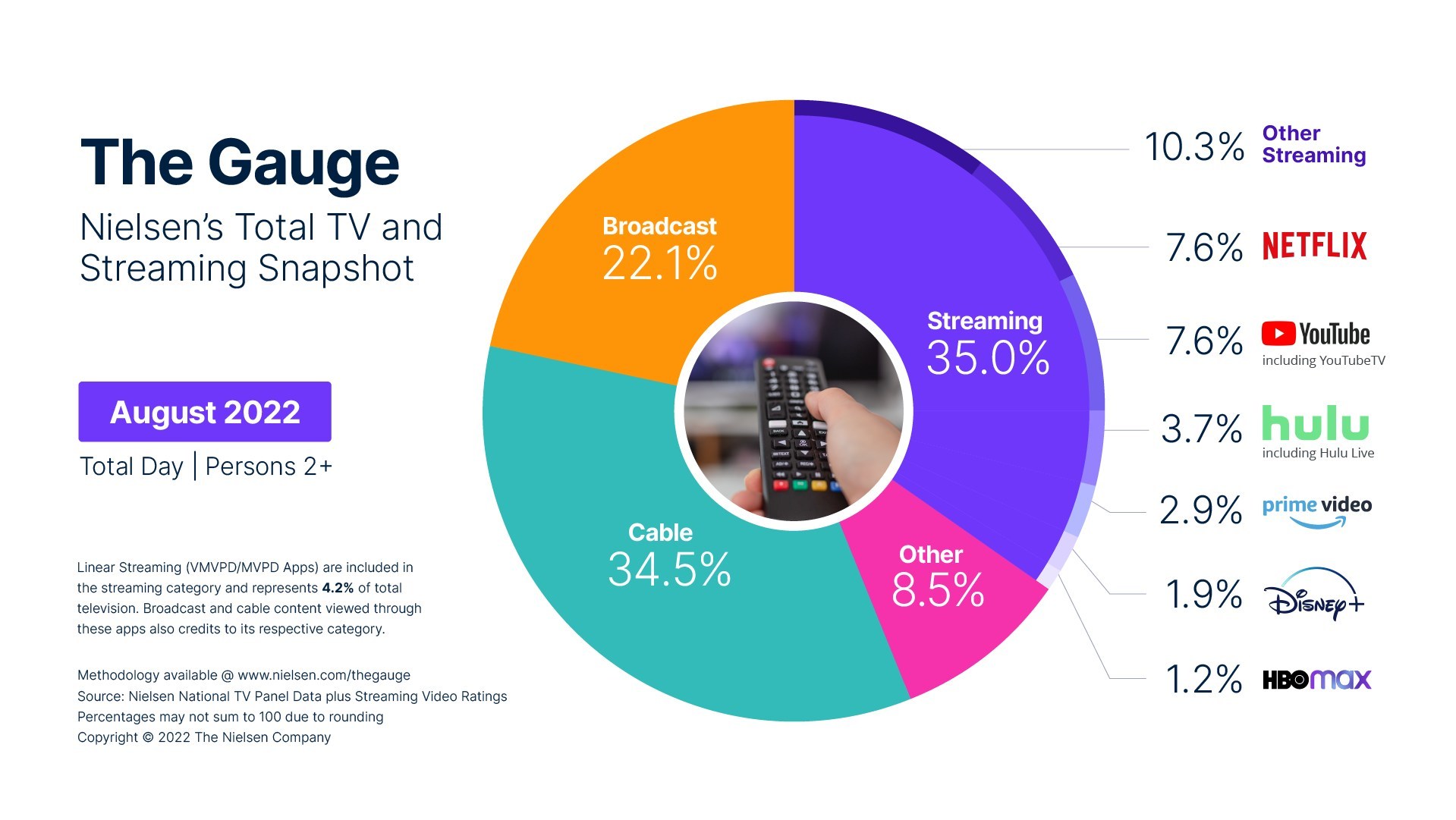Streaming Accounted for 35% of TV Viewing in August 2022
Broadcast’s share of TV viewing increased to 22.1% while YouTube tied Netflix for the first time as the most popular streaming platform on TV, according to Nielsen's The Gauge

NEW YORK—Streaming platforms continued to dominate TV viewing in August of 2022 with 35% of all TV viewing, narrowly beating out cable (34.5% of TV viewing), according to Nielsen’s The Gauge.
Broadcast lagged significantly behind with 22.1% of TV viewing but its volume and share of viewing increased from July, when it had a 21.6% share.
August was the second straight month where streaming platforms held the largest share of TV viewing and marked a record high share for streaming, Nielsen said.
The month also saw a notable shift in viewing share among the streamers with YouTube tying Netflix for the first time with the largest share of TV viewing.
Broadcast had a 1.6% increase in viewing volume which translated to an incremental +0.5 share points in August. August was its first month without a decline since January 2022, Nielsen said.
This was driven by an 11% viewing bump in the "general variety" genre, which includes shows like "Big Brother", and a 3% increase in sports content viewing which was due in part to the MLB Field of Dreams game, several NFL preseason games, and the return of college football.
Compared to one year ago, however, broadcast's viewing volume was down -10.9% in August and the category lost -2.4 share points.
Get the TV Tech Newsletter
The professional video industry's #1 source for news, trends and product and tech information. Sign up below.
Cable's share of TV was up +0.1 share points to 34.5% in August compared to July despite monthly usage remaining fairly flat, Nielsen said.
The category tracked a 27.4% increase in sports viewing, led by NFL preseason games on ESPN and the NFL Network, in addition to the NASCAR Cup Series on USA Network.
Nielsen also reported an 13% increase in cable news viewing, which is cable's most-watched genre, making up 19.3% of cable viewing. Compared to one year ago, cable's viewing volume was down -9.4% in August and declined -3.0 share points.
While streaming gained +0.2 share points in August, coming in at 35% total share, streaming viewing was flat compared to July. High-profile content on individual streaming platforms drove a number of shifts this month:
Among the individual streaming platforms, HBO Max recorded a 13.7% increase in viewing volume and a record-high 1.2% share, a lift led by the release of HBO's “House of the Dragon”.
Viewing of Netflix's “Stranger Things” steadily declined in August, leading to a 6.5% drop in usage and loss of -0.5 share points, bringing the streaming platform to 7.6% share of TV—only exceeded by Netflix's shares recorded in June and July 2022.
Time spent watching YouTube increased 2.8% in August and gained +0.3 share points, tying Netflix's share for the first time at 7.6% of total TV, Nielsen said.
YouTube TV viewing, which is included in YouTube's share of television, increased 14.9% in August compared to July and represented 11.9% of YouTube usage.
Compared to one year ago, streaming consumption was up +22.6% in August, representing a gain of 6.8 share points.
Linear Streaming, including live TV apps offered by MVPDs (multichannel video programming distributors such as Charter/Spectrum and DirecTV apps) and vMVPDs (virtual multichannel video programming distributors such as YouTube TV, Hulu Live), is included in the streaming category and represents 4.2% of total television usage, Nielsen explained. Broadcast and cable content viewed through linear streaming apps also credits its respective category.

George Winslow is the senior content producer for TV Tech. He has written about the television, media and technology industries for nearly 30 years for such publications as Broadcasting & Cable, Multichannel News and TV Tech. Over the years, he has edited a number of magazines, including Multichannel News International and World Screen, and moderated panels at such major industry events as NAB and MIP TV. He has published two books and dozens of encyclopedia articles on such subjects as the media, New York City history and economics.

